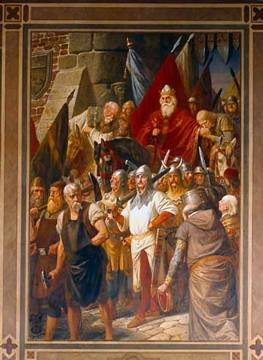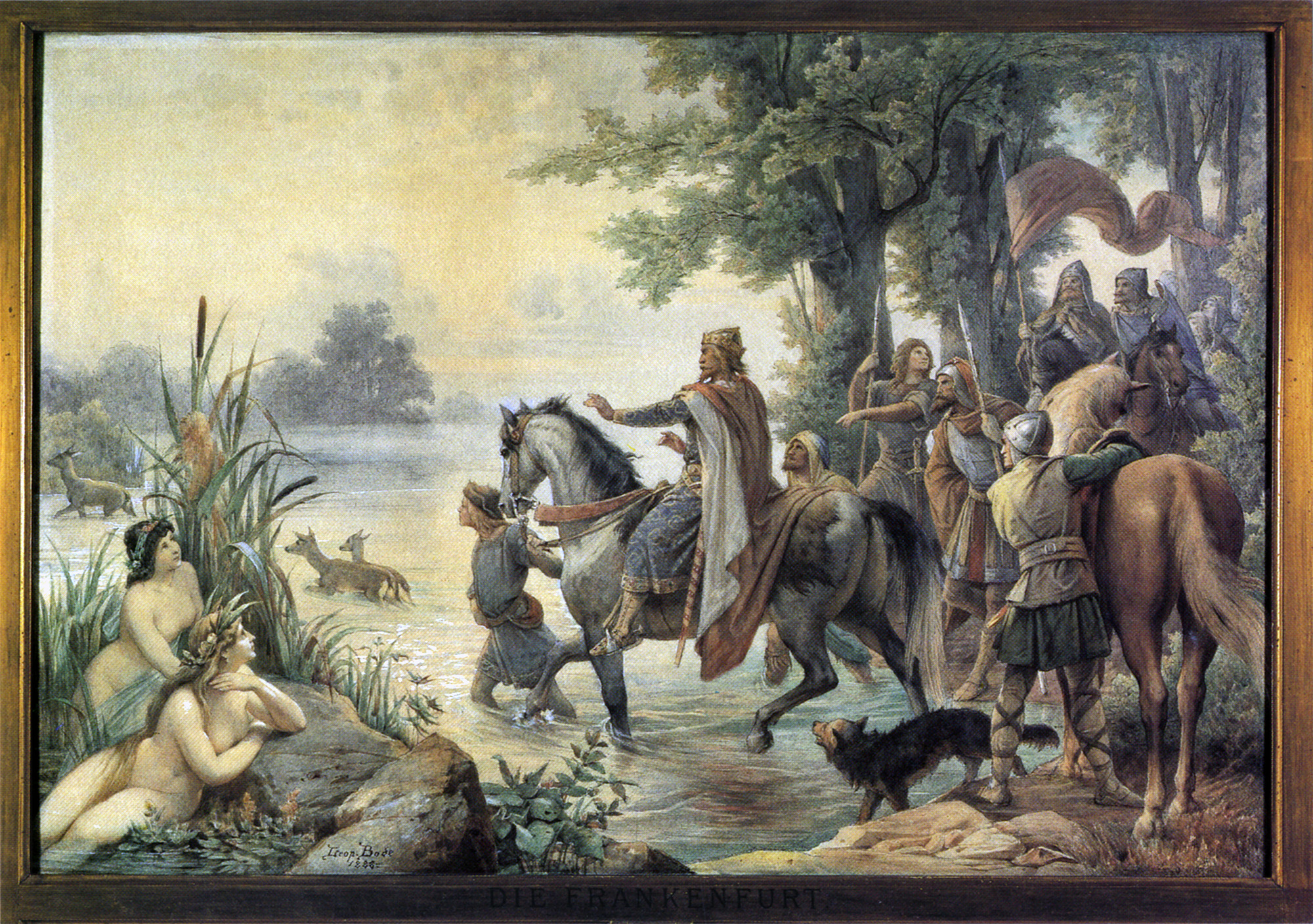|
Ewiger Landfriede
The ''Ewiger Landfriede'' ("everlasting '' Landfriede''", variously translated as "Perpetual Peace", "Eternal Peace", "Perpetual Public Peace") of 1495, passed by Maximilian I, German king and emperor of the Holy Roman Empire, was the definitive and everlasting ban on the medieval right of vendetta (''Fehderecht''). In fact, despite being officially outlawed, feuds continued in the territory of the empire until well into the 16th century. The ''Ewiger Landfriede'' graduated from the development of the peace movement (''Landfriedensbewegung''), which, after initial attempts in the 12th century, had its first significant success in the Treaty of Mainz in 1235. It was aimed primarily at the lesser nobles who had not kept pace with the process of development of the princely territories. Their propensity to feuding (''Fehdefreudigkeit'') increasingly went against the intent of the imperial princes and imperial cities to pacify and consolidate their territories. Claims were hencefort ... [...More Info...] [...Related Items...] OR: [Wikipedia] [Google] [Baidu] |
Landfriede
Under the law of the Holy Roman Empire, a ''Landfrieden'' or ''Landfriede'' (Latin: ''constitutio pacis'', ''pax instituta'' or ''pax jurata'', variously translated as "land peace", or "public peace") was a contractual waiver of the use of legitimate force, by rulers of specified territories, to assert their own legal claims. This especially affected the right of feuding. Scope ''Landfrieden'' agreements formed the political basis for pursuing claims without resorting to the private use of violence. They also often regulated the jurisdiction and thus allowed the settlement of disputes through judgements based on a common set of rules. Offences or violations of the public peace were liable to severe punishment. For example, objects or buildings (such as churches, homes, mills, agricultural implements, bridges, and especially imperial roads) and people (priests, pilgrims, merchants, women, even farmers, hunters and fishermen in carrying out their work) could be placed under prot ... [...More Info...] [...Related Items...] OR: [Wikipedia] [Google] [Baidu] |
Frankfurt
Frankfurt am Main () is the most populous city in the States of Germany, German state of Hesse. Its 773,068 inhabitants as of 2022 make it the List of cities in Germany by population, fifth-most populous city in Germany. Located in the foreland of the Taunus on its namesake Main (river), Main, it forms a continuous conurbation with Offenbach am Main; Frankfurt Rhein-Main Regional Authority, its urban area has a population of over 2.7 million. The city is the heart of the larger Rhine-Main metropolitan region, which has a population of more than 5.8 million and is Germany's Metropolitan regions in Germany, second-largest metropolitan region after the Rhine-Ruhr metropolitan region, Rhine-Ruhr region and the List of EU metropolitan regions by GDP#2021 ranking of top four German metropolitan regions, fourth largest metropolitan region by GDP in the European Union (EU). Frankfurt is one of the ''de facto'' four main capitals of the European Union (alongside Brussels, Luxembourg Cit ... [...More Info...] [...Related Items...] OR: [Wikipedia] [Google] [Baidu] |
1490s In The Holy Roman Empire
*
{{Number disambiguation ...
149 may refer to: *149 (number), a natural number *AD 149, a year in the 2nd century AD *149 BC, a year in the 2nd century BC *British Airways Flight 149, a flight from LHR to Kuwait City International Airport; the aircraft flying this flight was destroyed by Iraqi troops *149 Medusa, a main-belt asteroid See also * List of highways numbered 149 The following highways are numbered 149: Canada * Prince Edward Island Route 149 Costa Rica * National Route 149 (Costa Rica), National Route 149 India * National Highway 149 (India) Japan * Japan National Route 149 United Kingdom * road *B ... [...More Info...] [...Related Items...] OR: [Wikipedia] [Google] [Baidu] |
1490s In Law
*
{{Number disambiguation ...
149 may refer to: * 149 (number), a natural number * AD 149, a year in the 2nd century AD * 149 BC, a year in the 2nd century BC * British Airways Flight 149, a flight from LHR to Kuwait City International Airport; the aircraft flying this flight was destroyed by Iraqi troops * 149 Medusa, a main-belt asteroid See also * List of highways numbered 149 The following highways are numbered 149: Canada * Prince Edward Island Route 149 Costa Rica * National Route 149 (Costa Rica), National Route 149 India * National Highway 149 (India) Japan * Japan National Route 149 United Kingdom * road *B ... [...More Info...] [...Related Items...] OR: [Wikipedia] [Google] [Baidu] |
Law Of The Holy Roman Empire
Law is a set of rules that are created and are enforceable by social or governmental institutions to regulate behavior, with its precise definition a matter of longstanding debate. It has been variously described as a science and as the art of justice. State-enforced laws can be made by a legislature, resulting in statutes; by the executive through decrees and regulations; or by judges' decisions, which form precedent in common law jurisdictions. An autocrat may exercise those functions within their realm. The creation of laws themselves may be influenced by a constitution, written or tacit, and the rights encoded therein. The law shapes politics, economics, history and society in various ways and also serves as a mediator of relations between people. Legal systems vary between jurisdictions, with their differences analysed in comparative law. In civil law jurisdictions, a legislature or other central body codifies and consolidates the law. In common law systems, judges m ... [...More Info...] [...Related Items...] OR: [Wikipedia] [Google] [Baidu] |
Strafgesetzbuch
''Strafgesetzbuch'' (, literally "penal law book"), abbreviated to ''StGB'', is the German penal code. History In Germany the ''Strafgesetzbuch'' goes back to the Penal Code of the German Empire passed in the year 1871 on May 15 in Reichstag which was largely identical to the Penal Code of the North German Confederation from 1870. It came into effect on January 1, 1872. This ''Reichsstrafgesetzbuch'' (Imperial Penal Code) was changed many times in the following decades in response not only to changing moral concepts and constitutional provision granted by the ''Grundgesetz'', but also to scientific and technical reforms. Examples of such new crimes are money laundering or computer sabotage. The Penal Code is a Codification (law), codification of criminal law and the pivotal legal text, while supplementary laws contain provisions affecting criminal law, such as definitions of new types of crime and law enforcement action. The StGB constitutes the legal basis of criminal law ... [...More Info...] [...Related Items...] OR: [Wikipedia] [Google] [Baidu] |
Breaches Of The Peace
Breach of the peace or disturbing the peace is a legal term used in constitutional law in English-speaking countries and in a public order sense in the United Kingdom. It is a form of disorderly conduct. Public order England, Wales and Northern Ireland In England and Wales, theoretically all criminal offences cognizable by English law involve "a breach of the King's peace", and all indictments formerly concluded "against the peace of our Lord the King, his crown and dignity" before the passage of the Indictments Act 1915 and the Rules that formed that Act's first schedule. The conclusion has also found its way into constitutional law in many United States state constitutions, which mandate that indictments within the state end in a similar manner to the above, usually omitting the "crown" part or substituting "government". For example, New Jersey's is "against the peace of this State, the government and dignity of the same". Historically that concluding phrase, now legally supe ... [...More Info...] [...Related Items...] OR: [Wikipedia] [Google] [Baidu] |
Wetzlar
Wetzlar () is a city in the state of Hesse, Germany. It is the twelfth largest city in Hesse with currently 55,371 inhabitants at the beginning of 2019 (including second homes). As an important cultural, industrial and commercial center, the university town is one of the ten regional centers in the state of Hesse. A former free imperial city, it gained much of its fame as the seat of the Imperial Supreme Court (''Reichskammergericht'') of the Holy Roman Empire. Located 51 kilometers north of Frankfurt, at 8° 30′ E, 50° 34′ N, Wetzlar straddles the river Lahn and is on the German Timber-Frame Road, which passes mile upon mile of half-timbered houses. Historically, the city has acted as the hub of the Lahn-Dill-Kreis on the north edge of the Taunus. Tourists know the city for its ancient town and its medieval Catholic/Protestant shared Wetzlar Cathedral, cathedral of St. Mary. Notable architectural features include the Eisenmarkt and the steep gradients and tightly packed str ... [...More Info...] [...Related Items...] OR: [Wikipedia] [Google] [Baidu] |
Speyer
Speyer (, older spelling ; ; ), historically known in English as Spires, is a city in Rhineland-Palatinate in the western part of the Germany, Federal Republic of Germany with approximately 50,000 inhabitants. Located on the left bank of the river Rhine, Speyer lies south of Ludwigshafen and Mannheim, and south-west of Heidelberg. Founded by the Ancient Rome, ancient Romans as a fortified town on the northeast frontiers of their Roman Empire, it is one of Germany's oldest cities. Speyer Cathedral, a number of other churches, and the ("old gate") dominate the Speyer landscape. In the cathedral, beneath the high altar, are the tombs of eight Holy Roman Emperors and List of German monarchs, German kings. The city is famous for the 1529 Protestation at Speyer. One of the ShUM-cities which formed the cultural center of Jewish life in Europe during the Middle Ages, Medieval / Middle Ages, Speyer and its Jewish courtyard, Speyer, Jewish courtyard was inscribed on the UNESCO (United ... [...More Info...] [...Related Items...] OR: [Wikipedia] [Google] [Baidu] |
Imperial Chamber Court
The ; ; ) was one of the two highest judicial institutions in the Holy Roman Empire, the other one being the Aulic Council in Vienna. It was founded in 1495 by the Imperial Diet in Worms. All legal proceedings in the Holy Roman Empire could be brought to the Imperial Chamber Court, except if the ruler of the territory had a so-called '' privilegium de non appellando'', in which case the highest judicial institution was found by the ruler of that territory (though the privilege could be bypassed if a litigant could claim they had been denied due process). Another exception was criminal law in which the Imperial Chamber Court could intervene only if basic procedural rules had been violated. The Imperial Chamber Court was infamous for the long time that it took to reach a verdict. Some proceedings, especially in lawsuits between different states of the Empire, took several hundred years. Some of the lawsuits had not been brought to an end when it was dissolved in 1806 following t ... [...More Info...] [...Related Items...] OR: [Wikipedia] [Google] [Baidu] |
Maximilian I (HRR)
Maximilian I (22 March 1459 – 12 January 1519) was King of the Romans from 1486 and Holy Roman Emperor from 1508 until his death in 1519. He was never crowned by the Pope, as the Italienzug, journey to Rome was blocked by the Republic of Venice, Venetians. He proclaimed himself elected emperor in 1508 at Trento, Trent, with Pope Julius II later recognizing it. This broke the tradition of requiring a papal coronation for the adoption of the Imperial title. Maximilian was the only surviving son of Frederick III, Holy Roman Emperor, and Eleanor of Portugal, Holy Roman Empress, Eleanor of Portugal. From his coronation as King of the Romans in 1486, he ran a double government, or ''Doppelregierung'' with his father until Frederick's death in 1493. Maximilian expanded the influence of the House of Habsburg through war and his marriage in 1477 to Mary, Duchess of Burgundy. However, he also lost his family's lands in Switzerland to the Swiss Confederacy. Through the marriage of his son ... [...More Info...] [...Related Items...] OR: [Wikipedia] [Google] [Baidu] |






